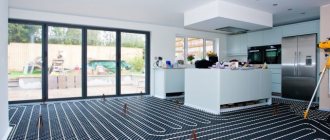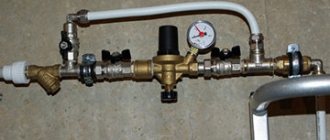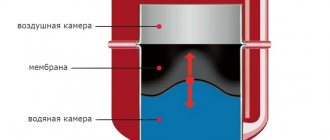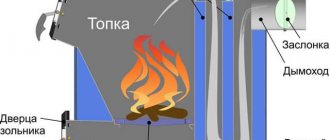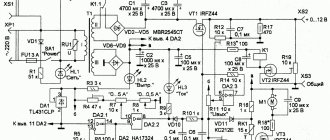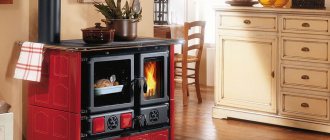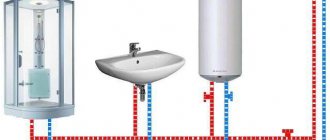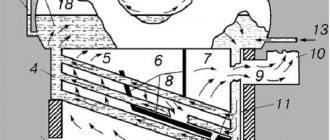Most often, residential private houses are heated with a water heating system, in which the heated liquid (not only water can be used, but also special antifreeze - non-freezing liquids) moves through pipes and transfers heat to heating radiators.
Heating systems can be divided into two types:
- with natural circulation of fluid throughout the system,
- with forced movement of coolant.
In the case of forced circulation, the coolant moves thanks to a circulation pump.
How to choose a circulation pump for heating
To select equipment taking into account the most suitable parameters, you must use certain formulas
. However, only specialists know which formulas need to be used in each specific case. And if the device is selected by an unknowing person, then you should use the following recommendations:
- Marking of the circulation pump
. For example, Grundfos UPS 25-50 equipment, where the first two digits indicate the thread diameter of the nuts - 25 millimeters (1 inch), which are supplied with the device. There are also pumps with nut diameters of 32 millimeters (1.25 inches). The second two digits are the maximum height of coolant rise in the heating system - 5 meters, that is, using a circulation pump, an excess pressure of no more than 0.5 atmospheres can be created. There are also pumps in which the lift height is 3, 4, 6 and 8 meters. - Unit performance
.
It is the main parameter that determines the operation of the unit. Represented by the volume of coolant pumped using a pump. The formula used for calculation is: Q=N:(t2-t1), - where N is the power of the heat source. This could be a boiler or a gas water heater;
- t 1 – shows the temperature of the water in the return pipe. As a rule, it is +65-70 0 C;
- t 2 - shows the temperature of the water that is in the supply pipeline (coming out of the boiler or geyser). Often the boiler maintains +90-95 0 C.
- Calculation of the heating system and its losses is carried out in order to correctly select the design parameters of the unit that is able to cope with the resistance in the heating system.
. Shows the maximum pressure that the heating system is capable of. This is the total value of hydraulic resistance in the heating system. When calculating hydraulic resistance, the number of floors of a heated building with a closed heating system is not taken into account. In this case, the average value is taken - 2-4 meters of water column. In low-rise buildings with a traditional heating system, this figure is identical.
This is another parameter that is worth considering when choosing a circulation pump, albeit indirectly. This indicator is indicated in the building's passport during its design. If these values are missing, they can be calculated. Each country has its own heat standards per square meter. According to European standards, 100 W are required to heat 1 square meter of a one- or two-apartment building, and 70 W for an apartment building. The Russian standard is presented in SNiP 2.04.05-91.
. Any heating circulation pump has three connection positions to the electrical network. All information regarding the electric current consumption of the pump is contained in the plate on the unit body (load parameters). Each switch position corresponds to a new pump performance, that is, the amount of coolant per hour pumped by the device through the heating system. The third position of the switch shows the maximum performance of this unit, and the maximum current consumption by the pump is indicated on the plate on the pump body.
Mass-produced equipment has average characteristics. Therefore, it is necessary to take into account the individuality of each heating system.
Note! Selecting a suitable pump should take into account the ability of the unit to operate in several modes, and its power should exceed the design power by 5-10 percent
Operating principle of the automatic recharge unit
Once a drop in system pressure is detected, the adjustable pressure sensor is activated and the pump contacts are closed. The coolant is topped up either from the water supply or from a storage tank. After reaching the required coolant pressure in the system, the pump turns off.
This device has another undeniable advantage - using a make-up pump you can pump coolant into the system without disassembling the heating system. This may be necessary to repair or replace the coolant.
How to use a boiler room thermal diagram
The thermal circuit helps monitor the condition and operation. Due to flue gases, corrosion of low-temperature or sulfuric acid metal coatings cannot be ruled out. And to prevent it from appearing, the water temperature should be monitored. It is noteworthy that at the entrance to the boiler the optimal temperature will be 60-70 degrees.
And in order to be able to increase the temperature to the required levels, a recirculating pump is installed. Water heating boilers need to be monitored so that their service life is decent; control the consistency of water consumption. Typically, the minimum data for this indicator is set by the manufacturer.
In order for boiler rooms to work well, you need to use vacuum deaerators. Typically, a water jet ejector will create a vacuum, and the released steam will be used for deaeration. But, the main thing that they are afraid of when installing a boiler room is permanent attachment to the place. Modern automation simplifies many processes.
Manual recharge scheme
The simplest option for filling the system is implemented in 90% of double-circuit wall-mounted boilers, where a cold water supply pipe is a priori connected. A manual valve is installed inside the housing, connecting this line with the heating return line. Often, a boiler feed tap is found on solid fuel heat generators with and without a water circuit (for example, heating units of the Czech brand Viadrus).
Reference. On some models of gas heaters equipped with a DHW heat exchanger (in particular, Beretta), instead of a manual tap, manufacturers install an automatic make-up valve with an electromagnetic drive. If the coolant pressure drops below 0.8 Bar, the boiler itself draws water to the required level.
In wall-mounted double-circuit heat generators, the make-up valve is located at the bottom, where the pipelines are connected
. To assemble a classic make-up unit suitable for any type of system, you will need the following parts:
- tee with side outlet DN 15-20, corresponding to the material of the heating main pipe - fitting for metal-plastic, polypropylene, and so on;
- poppet (spring) check valve;
- ball valve;
- couplings, fittings.
The purpose of the check valve is to prevent water from the heating network from flowing back into the water supply system. If we are talking about pumping antifreeze using a pump, you cannot do without a valve. The fittings are installed in the order listed:
- The tee cuts into the heating return after the circulation pump.
- A check valve is connected to the outlet pipe of the tee.
- Next is a ball valve.
Advice. If there is no fine filter at the entrance of the water supply to a private house, it is advisable to provide one on the make-up line. The element will protect the heating system from the entry of fine sand and rust particles that accumulate on the check valve plate and in the seats of three-way valves.
The operating principle of the unit is simple: when the tap is opened, water from the centralized main flows into the heating pipelines, since its pressure is higher (4-8 Bar versus 0.8-2 Bar). The filling process of a closed system is monitored by a boiler or safety group pressure gauge. If you accidentally exceed the pressure, use the Mayevsky tap on the nearest radiator and bleed off excess water.
To control the amount of coolant in the expansion tank of an open heating network located in the attic of the house, the tank must be equipped with 2 additional tubes with a diameter of ½ inch:
- The control line, ending with a tap in the boiler room, cuts into the side wall at approximately half the height of the tank. By opening this valve, you can determine the presence of water in the tank without climbing into the attic.
During the replenishment process, air bubbles escape through the tank lid, the maximum level is monitored by the flow of water from the upper fitting through the pipe - The overflow tube is inserted 10 cm below the tank lid, the end is discharged into the sewer or simply onto the street under the roof overhang. Being in the furnace room and opening the feed tap, you should see this pipe; when water flows from there, filling stops.
Comment. If you are interested in calculating the minimum volume of the expansion tank, follow the dedicated link.
The circuit with a check valve and shut-off valve is also applicable for filling solar systems (solar collectors) and geothermal circuits of heat pumps with antifreeze. How to use the boiler make-up valve is described in the video:
Features of connecting pumping equipment
If a forced circulation system is used to service the house, then when the electrical power is turned off, the boiler pump must continue to operate, receiving energy from a backup source. In this regard, it is best to equip the heating system with a UPS, which will maintain the operation of the structure for several more hours. External batteries connected to it will help extend the life of the backup source.
When connecting the pump, you must avoid the possibility of condensation and moisture getting into the terminals. If the coolant heats up to more than 90 °C, then a heat-resistant cable is used for connection. You will also need to avoid contact of the pipe walls and power cable with the motor and pump housing. The power cable is connected to the terminal box on the right or left side by changing the location of the plug. In the case of a side-mounted terminal box, the cable must be routed only from the bottom. A prerequisite is that grounding must be connected to the pump.
Mains pumps are often used in boiler rooms. Such products perform the function of pumping hot water in a heating network system. The temperature of the network water, which the installed unit is capable of driving through the pipes, reaches +180 degrees.
At the same time, the device and design of network pumps are relatively simple, and at the same time, the devices show a high level of performance along with reliability.
Signs of a critical coolant shortage
Not all owners of private houses monitor the technical condition of their water heating; it works - and that’s okay. When a hidden leak occurs, the system continues to function for some time until the amount of coolant drops to a critical level. This moment is monitored by the following criteria:
- In an open system, the expansion tank is first emptied, then the main riser rising from the boiler is filled with air. Result: cold batteries when the supply pipeline overheats; turning on the maximum speed of the circulation pump does not help.
- The lack of water during gravity distribution manifests itself in a similar way; in addition, the gurgling of water in the riser can be heard.
- On a gas heater (open circuit), frequent starts/turns of the burner are observed - clocking, the TT boiler overheats and boils.
- The lack of coolant in a closed (pressure) circuit is reflected on the pressure gauge - the pressure gradually decreases. Wall-mounted models of gas boilers automatically stop when they fall below a threshold of 0.8 Bar.
- Floor-standing, non-volatile units and solid fuel boilers continue to regularly heat the remaining water in a closed system until the volume vacated by the coolant is filled with air. The circulation will stop, overheating will occur, and the safety valve will operate.
Important clarification. When a TT boiler operating in an open gravity system boils, there will be no explosion, since the coolant communicates with the atmosphere. The water heated by the heater will evaporate, and then a fire will start in the boiler room. Although the described process takes a lot of time, such situations are far from uncommon.
We will not explain why the system needs to be recharged - this is an obvious measure to maintain the functionality of the heating. All that remains is to choose a method for replenishing the heating network.
Feed pump for steam boiler device device
Each pump for a heating boiler performs its tasks in a closed-type heating system. The main element of such a pump is the rotor, on which the efficiency of the unit directly depends. When the pump operates, the rotor rotates inside the stator, which is fixedly mounted on a solid base. Some models are equipped with a ceramic stator, which protects the rotor from limestone.
The edges of the rotor are equipped with blades, the rotation of which pushes the coolant further through the pipes. For the most part, boiler pumps are equipped with one rotor, but there are models with several working elements. The rotor is driven by an electric motor. The motors of most pump models are characterized by high power and long service life. All pump elements are housed in a durable aluminum or stainless steel housing.
Conclusion on the topic
Automated make-up is a practical option for a large house with a complex multi-circuit heating system. The financial costs of organizing it will be a small percentage of the total investment in heat supply. A small closed autonomous heating system is easier and cheaper to maintain yourself. In addition, there is no point in installing equipment whose operation requires power supply on a gravitational one.
Most homeowners connect a water pipe to the heating circuit through a shut-off valve, and manually refill the water using pressure gauge readings.
Video on the topic:
Rules for installing boiler pumps
Any equipment, be it a unit for a heating system, or a pump for flushing boilers, must be installed strictly in accordance with the manufacturer’s recommendations. One of the most important conditions is to choose the correct location of the device. The pump shaft must be positioned strictly horizontally. Otherwise, air pockets will form inside the system, which will leave the bearings and other elements of the unit without lubrication. The result of this will be rapid wear of the device parts.
Another important condition is the correct choice of location for inserting the pump. The unit must force liquid to move through the pipeline
The standard installation diagram of the device is shown in the image below.
The main elements in the diagram are shown in this order:
- boiler;
- coupling connection;
- valves;
- alarm system;
- pump;
- filter;
- membrane type tank;
- heating radiators;
- liquid feed line;
- Control block;
- temperature sensor;
- emergency sensor;
- grounding
This scheme ensures the most efficient operation of the pump and heating system. At the same time, energy consumption by each individual element of the system is reduced to a minimum.
Features of recharging an open heating circuit
Features of recharging an open heating circuit
The open system has an expansion tank. It is installed in the highest part of the “highway”. It helps cope with the thermal expansion of water, compensating the heating pressure. To determine the level of liquid from the container, a control tube is installed in the kitchen or bathroom. A shut-off valve is installed at the end of this tube; it will help avoid leakage and excessive water consumption.
At the control time the tap opens. If the water flows then everything is fine. Otherwise, the water level must be refilled immediately.
A gravity heating system has three main elements:
- a ball valve is necessary to transfer coolant from the water supply to the heating system,
- the filter helps eliminate dangerous impurities,
- The non-return valve prevents mixing of drinking water and liquid from the heating system.
Classification
All pumps are divided into two types:
Dry rotor pump
The working part of the rotor does not have direct contact with water thanks to the protection of several sealing wheels. These parts are made from carbon agglomerate, high-quality steel or ceramics, aluminum oxide - it all depends on the type of coolant used.
The device is launched by the movement of the rings relative to each other. The surfaces of the parts are perfectly polished, in contact with each other, they create a thin layer of water film. As a result, a sealing connection is created. With the help of springs, the rings are pressed towards each other, due to which, as the parts wear out, they independently adjust to each other.
The service life of the rings is approximately three years, which is much longer than the life of the stuffing box, which requires periodic lubrication and cooling. The efficiency indicator is 80 percent. The main distinguishing feature of the unit is its high noise level, as a result of which a separate room is required for its installation.
Glandless rotor pump
The working part of the rotor - the impeller - is immersed in the coolant, which simultaneously acts as a lubricant and as an engine coolant. Using a sealed stainless steel cup installed between the stator and rotor, the electrical part of the engine is protected from moisture.
As a rule, ceramics are used
, for bearings - graphite or ceramics, for the housing - cast iron, brass or bronze. The main feature of the unit is its low noise level, long period of use without maintenance, easy and simple settings and repairs.
The efficiency indicator is 50 percent. This is explained by the fact that sealing the metal sleeve, which separates the coolant and the stator, is impossible if the rotor diameter is large. However, for domestic needs, where coolant circulation is ensured in short-length pipelines, it is advisable to use such circulation pumps.
Composed of a modular design
modern “wet” type devices include:
- Frame;
- Electric motor with stator;
- Box with terminal blocks;
- Working wheel;
- A cartouche consisting of a shaft with bearings and a rotor.
The modular assembly is convenient because at any time it is possible to replace a failed part of the circulation pump with a new part, and accumulated air can be easily removed from the cartouche.
Reasons for reducing coolant volume
A decrease in the level in heating systems of a private house occurs due to the following number of reasons:
- Leak. Often the coolant begins to flow at the joints. It most often appears immediately after the crimping process. Therefore, they can be detected and eliminated immediately. However, there are also hidden, old leaks. It is quite difficult to identify them, due to the fact that they are located in concrete floor or wall screeds. To detect such an accident, it is often necessary to use a thermal imager. The only way to avoid this is to make all joints in an open, serviceable area.
- Exceeding operating parameters of a critical level. For example, if the coolant suddenly overheats, its pressure will increase sharply and exceed the permissible level for the equipment. As a result, the emergency valve will operate, which, in contrast to the replenishment module, will independently begin to eject liquid from the heating system until the internal pressure returns to normal.
Triggering of the emergency valve leads to the release of part of the coolant from the system Source stroy-podskazka.ru
Grundfos make-up pumps develop quite high pressure
How to get a discount?
Click “I like”
Print the coupon
Get a discount!
- Click the “like” button on any of the presented social networks.
- In the pop-up window that appears, click the “print coupon” button. A discount coupon will appear in front of you.
- Print out a coupon that entitles you to a discount of 5% to 20% on products and services of our company!
Authorized Grundfos service partner
Service
warranty and post-warranty
on objects of any complexity
Commissioning
Pumping technology has evolved quite a lot since its introduction into the national economy. At the moment, such devices are often equipped with all kinds of automation. Starting from protection against dry running, mechanical check valves that prevent reverse flow of the pumped substance, and ending with powerful electronic units that allow you to regulate the rotation speed, changing the frequency of the electric current, and measure various characteristics in real time: temperature, current, flow rate, and the like .
These processes did not pass by Grundfos pumps for recharging the heating system and boiler. These modern devices combine excellent quality with the use of the latest achievements of science and technology. Despite, at first glance, their auxiliary function, these devices are capable of creating quite high pressure, which allows them to be used even during the initial filling of the system, or during a planned replacement of the coolant.
And for a more detailed overview of the range, you can refer to the catalog of Grundfos charging pumps, located on the website of the official representative of the manufacturer in our country.
Installation of a chiller and air conditioning system in a shopping center building on Kashirskoye Shosse in Moscow
Employees of JSC “Unified Service Center” installed a chiller and related equipment in the building of a shopping center on Kashirskoye Shosse.
Where to buy “Grundfos charging pumps”?
Shipment of the product “Grundfos make-up pumps”
– pick up at the address Moscow, 127282, Polyarnaya street, building 31A, building 1. (show map)
In other cities
The cost of delivery to these cities depends on the availability of goods at the local warehouse. You can check current availability by calling our office in your city:
We can offer you the lowest possible price and shortest delivery times compared to competitors in your region.
The role of Grundfos booster pumps in the heating system
For heating systems, the role of pumping technology is especially important. Firstly, many modern systems require forced circulation of coolant in the circuit, and secondly, from time to time the system requires replenishment of the volume of coolant fluid. It is possible to create an absolutely sealed circuit, but this will not be a panacea, because after a certain period of time a partial or complete replacement of the coolant is required, depending on the technical conditions of the heating system. Also, do not forget about scheduled maintenance, which involves flushing the radiators and the circuit as a whole, which implies depressurization of the heating circuit. Therefore, regardless of the geographical location of the owner of the heating system (for example, in Lyubertsy), he will need a Grundfos feed pump.
Why are make-up pumping units needed?
The answer to this question covers many areas of industrial and domestic applications. We are talking about air conditioning, heating, ventilation and other engineering structures. And implementation in various auxiliary and main production processes allows the use of Grundfos booster pumps even for aggressive environments and liquids. This will ensure the non-stop operation of a production line, for example a SIP washing machine, which is a critical element in the food industry.
Various designs of the units allow them to be used under any environmental conditions: in a residential area, in a workshop, in a boiler room, outdoors. After all, the manufacturer has taken care of all possible ways to use this type of equipment. And even a Grundfos street pump has been developed, which is popular in Korolev and Mytishche.
Now you only need to carefully select the model of the required booster pump, based on the technical conditions of your system.
Possible problems when feeding a closed system
At first glance, such a unit for automatic replenishment of the heating system is ideal for a closed system with forced water circulation. However, when using the block in practice, you may encounter the following problems.
Low pressure in the water supply
According to standards, the pressure level in the water supply network should not exceed 4 atm. The same value for heating is usually no more than 3 atm. Those. theoretically, when the valve seat is opened, a high-pressure flow from the water supply will flow into the heating main. However, in practice this does not always happen. This is especially true for autonomous water supply systems. If the pressure in the water pipe is lower than in the heating pipe, the coolant will not flow, but will flow out of the system.
To solve this problem, it is necessary to install a check valve, and you will also need a pump to recharge the heating system. The latter will create the required level of pressure in the feed line. To turn it on, you will need to install several additional elements along with the heating system feed valve:
- Pressure gauges with switching relay connected to the pump;
- Reducing valve opening sensor;
- Storage tank.
This automatic replenishment unit for the heating system will work as follows. If the valve opening sensor is triggered and the pressure value on the pressure gauge is below critical, the circulation pump automatically turns on to recharge the heating system. If there is no water in the water supply, it will come from the storage tank.
Membrane sticking
This problem is typical during long-term operation without turning on the automatic refill heating system. Regardless of the material of manufacture, a slight limescale deposit will appear on the inner walls of the gearbox. It will prevent the valve from opening, which will lead to an emergency.
To avoid this, before starting the system, and then at least once a month, open the stem manually. This will make it possible to verify the operation of the system, and will also help prevent a critical drop in the level of hot water in pipes and radiators.
It is best to use stainless components to recharge the heating system. Valves, pumps, components installed according to the scheme will then last much longer. Brass products are somewhat inferior in their performance characteristics to stainless steel products.
Monoblock pump
Previously, pumping units mounted on a foundation or frame, consisting of a pump and a drive, were used as network pumps. Mechanical energy was transmitted from the drive to the pump through a group of drive mechanisms. This was primarily due to the need to use powerful drives.
- The modern range of pumping equipment allows the use of monoblock pumps as network pumps.
- The use of monoblock pumps allows, first of all, to significantly save installation space.
- This is especially true when using monoblock pumps with a vertical shaft.
- The use of modern pumping equipment when modernizing existing boiler houses makes it possible to reduce the required installation area by two or more times.
Buy a network monoblock pump from Interpamps
Interpamps LLC offers reliable pumping equipment of the Etaline and Etaline-R series, with a capacity of up to 2000 cubic meters per hour, and a pressure of up to 100 meters of water column, designed for operating pressure up to 25 bar and temperatures from -30 to +140 degrees Celsius . Due to their design and operating parameters, Etaline pumps can be used as network pumps, both in stationary boiler houses and in block-modular ones. The nozzles located on the same axis in Etaline pumps greatly simplify the piping of the pumps. Allowing, among other things, the installation of Etaline pumps directly into an existing pipeline without changing the latter. The high efficiency and reliable design of the pumps can significantly reduce the cost of subsequent operation.
The central office of Interpamps LLC is located in Moscow, we offer our partners to buy high-quality pumping equipment inexpensively. We select pumping equipment at the request of our partners free of charge and in the shortest possible time.
The circulation pump for a heating system boiler performs a rather important function - it is responsible for the uninterrupted circulation of coolant through pipes and radiators. The efficiency of the heating system and the comfort of living in a private house or apartment largely depend on the choice of unit.
Other types of coolant
Propylene glycol has lubricating properties, therefore extending the life of the system
Water is not the only heat carrier that can be used to fill the heating circuit in a house or apartment. To improve performance properties, other liquids are used, for example, antifreeze. It does not freeze at subzero temperatures, so pipes and batteries do not burst in the cold. To fill in antifreeze, pipes with a small diameter and panel radiators are installed. This will reduce the amount of coolant and save money.
It is more difficult to fill the system with other liquids than with water. It cannot be pumped from a water pipe, so the algorithm will be different.
- To pump liquid into the heating circuit, you will need a manual (pressurized) pump. Electric models are not suitable as they require a special mechanism. A manual device helps create the nominal antifreeze pressure.
- A hose is attached to the check valve at the bottom of the system. A large capacity container is installed next to it. The second end rises to a height (second floor, attic) to create increased pressure.
- When the filling is completed, the liquid is drained from the attached hose.
After filling, you can check and use the heating devices.
In addition to antifreeze, propylene glycol can be used. This substance differs from other coolants in its positive properties. The main advantages include:
- Safety for humans. For this reason, many manufacturers recommend using it in double-circuit and single-circuit boilers.
- Maintains fluidity in all conditions. Does not freeze even at subzero temperatures.
- Availability of lubricating properties. Allows you to reduce the load on the pump.
- High inertia.
- Safe for all materials. Will not damage the flooring in case of leakage.
Monoblock pump
Previously, pumping units mounted on a foundation or frame, consisting of a pump and a drive, were used as network pumps. Mechanical energy was transmitted from the drive to the pump through a group of drive mechanisms. This was primarily due to the need to use powerful drives.
- The modern range of pumping equipment allows the use of monoblock pumps as network pumps.
- The use of monoblock pumps allows, first of all, to significantly save installation space.
- This is especially true when using monoblock pumps with a vertical shaft.
- The use of modern pumping equipment when modernizing existing boiler houses makes it possible to reduce the required installation area by two or more times.
Buy a network monoblock pump from Interpamps
Interpamps LLC offers reliable pumping equipment of the Etaline and Etaline-R series, with a capacity of up to 2000 cubic meters per hour, and a pressure of up to 100 meters of water column, designed for operating pressure up to 25 bar and temperatures from -30 to +140 degrees Celsius . Due to their design and operating parameters, Etaline pumps can be used as network pumps, both in stationary boiler houses and in block-modular ones. The nozzles located on the same axis in Etaline pumps greatly simplify the piping of the pumps. Allowing, among other things, the installation of Etaline pumps directly into an existing pipeline without changing the latter. The high efficiency and reliable design of the pumps can significantly reduce the cost of subsequent operation.
The central office of Interpamps LLC is located in Moscow, we offer our partners to buy high-quality pumping equipment inexpensively. We select pumping equipment at the request of our partners free of charge and in the shortest possible time.
If the boiler room is designed correctly, it will serve the heating system, ventilation, and supply of hot and cold water. It can be said that no one designs communications independently. Focus on at least a standard plan. Its choice depends on the type of room for which it is intended.
The graphic drawing must reflect all the mechanisms, apparatus, instruments, as well as the pipes connecting them. Standard boiler room plans include boilers, pumps (circulation, make-up, recirculation, network), and battery and condensation tanks. Also provided are devices for fuel supply and combustion, as well as devices for deaerating water, heat exchangers, the same fans, heat shields, and control panels.
Those heating networks that operate on water are divided into two groups:
- Open (the liquid is taken from local installations);
- Closed (water returns to the boiler, giving off heat).
The most popular example of a schematic diagram is an example of an open-type hot water boiler house. The principle is that a circular pump is installed on the return line; it is responsible for delivering water to the boiler, and then throughout the entire system. The supply and return lines will be connected by two types of jumpers - bypass and recirculation.
The technological diagram can be taken from any reliable sources, but it would be good to discuss it with specialists. He will advise you, tell you whether it is suitable for your situation, and explain the entire system of action
In any case, this is the most important structure for a private home, so maximum attention should be paid
Which pipe should I pour antifreeze through?
This is what the feed tap looks like
Before you get started, you need to know how to fill your heating system with antifreeze. There are two types of heating circuits. In one, the coolant is in contact with air, and in the other, circulation takes place in a completely closed circuit. The operating principle of these circuits is different, but they are united by the fact that antifreeze can be used in both. To pour antifreeze into the heating circuit you will need a pump. Coolant can be poured into open circuits in buckets, but in the case of non-freezing liquid this will take too long.
Antifreeze is poured into the heating system, in theory, through a make-up valve, if one is available. If it is not there, then the following options are possible:
To fill the heating circuit with antifreeze through the radiator plug, you need to unscrew it and screw in a tap instead.
A pump is connected to this tap, thanks to which antifreeze enters the pipes. After filling the heating system with antifreeze is completed, the tap remains at the end of the battery. This will allow you to recharge the system during operation, as well as use it as a drain when you need to empty the circuit of coolant.
In closed circuits there is a membrane expansion tank, for which there is a separate pipe. When the system is full, it is recommended to temporarily remove the expansion chamber. Is it possible to fill the heating system with antifreeze when the tank is not removed? It’s possible, but most likely, after this the expanzomat will still have to be removed and reconfigured. The expansion tank is installed both up and down.
The second method is more preferable, and the valve is installed on the pipe in different ways. Some installers install American valves with a tap in such a way that the shut-off valves remain on the circuit, while some, on the contrary, install them in such a way that the tap is removed together in the expansion chamber.
In the first case, there will be no problems with filling the circuit through the expansion tank pipe. In the second case, you will need to install such a tap. A hose from the pump is connected to the shut-off valve and antifreeze is poured into the pipes. Upon completion of the work, the ball valve is closed and the expansion chamber is installed.
Even if you do not have recharge coming from the pipes, this does not mean that there is none at all. Modern boilers always have a make-up pipe. For this reason, installers may not install another tap in the circuit itself. The boiler feed, if the system operates on water, is often connected to the water supply. If antifreeze is used, the pipe remains free and a pump can be connected to it.
Do you know that you can do alternative home heating with your own hands and not pay contractors? It's possible.
Read about why you sometimes have to resort to heating a wooden house with electricity here.
What you need to know about it
First of all, it is advisable to study the design of the heating system and understand the essence of its operation. Let's start with the fact that heating begins with boiler rooms, where some kind of fuel is burned (gas, coal, wood), and then the heat is transferred through pipes using a coolant. There are several types of coolants: air, steam and the most common - water. But water tends to freeze at low temperatures. Therefore, where necessary, antifreeze diluted with water is used in order to reduce the negative destructive effect on the pipeline. A calculation is made to help determine the correct ratio of water and antifreeze. With central heating, the coolant can be directed through a pumping system or through a conventional one.
The conventional, or natural, system is very simple: water heated in the boiler moves through some pipes, warming up the radiators, and then returns through others to heat up again. This simple device also has an expansion tank and air vents. The latter are needed in order to eliminate air bubbles and various gases that may accumulate in the pipes. And excess moisture, which appears when water expands from heating, goes into the expansion tank.
A closed heating system is characterized by a pump. It helps to accelerate the water faster than it moves in a conventional pumpless system. A pump is especially needed if the pipes are too narrow and this prevents the coolant from circulating.
How to fill the heating system in an apartment building
Scheme of water heating with associated movement of water: 1 – boiler; 2 – main riser; 3 – expansion tank; 4 – air collector; 5 – supply risers; 6 – return risers; 7 – return line; 8 – expansion pipe; 9 – pump; 10 – direction of pipe slope.
The water valve located in the house should be closed, and the water discharge on the coolant supply pipeline is gradually opened. At this time, the discharge on the return line is blocked. Then you need to very slowly open the valve on the return line until it is completely open
Caution must be exercised because if the high-pressure water supply of a general heating system is suddenly opened, this can lead to sudden changes in pressure, causing water hammer. The shock can be so powerful that one will be enough to break the system in the most vulnerable places
It will take some time for the heating system to fill. Reset should be monitored continuously. When water flows without any admixture of air bubbles, and this can be understood by the cessation of the characteristic hissing sound, close the discharge valve. Now it’s time to open the water supply valve to a specific room. At the final stage, all that remains is to bleed the air from all heating circuits. This method of filling the system with water is provided for.
A system with top piping looks much easier to use
In this case, you should simultaneously, with the same caution, open both dampers at once, while the discharge should be closed. To bleed air, go up to the attic of the building and open the air valves provided by the design
What pumps are used for boiler rooms
Network pumps for boiler houses are most often centrifugal, equipped with an electric motor. By type they can be divided into: condensate, network, make-up, intended for raw water. You can also find this type of pump as a nutrient pump.
In water supply boiler systems, it is customary to install several devices at once that have the same characteristics. The pumps are connected in parallel, with one of them being the main one, and the second being a backup and starting as needed when the first one fails. However, it is also possible to operate two devices at once. In this case, the water pressure in the pipes remains the same as when operating one installation, but the water supply increases, the level of which becomes equal to the sum of the supply of each of the devices.
Pumps for boiler rooms can have enormous weight and dimensions
For boiler houses, the best option would be to install a centrifugal 1-stage pump type KM, a 1-stage unit type D with 2-way suction, or a multi-stage product type TsNSG. In addition, many professionals recommend installing condensate type KS units in the boiler room. In this case, the final choice depends on the specific requirements of the buyer, which, as a rule, are determined by the operating conditions of the future equipment.
Selecting a device and calculating the required pressure
Pumps for boiler rooms are selected strictly based on the requirements of the heating system, or more precisely, on the required pressure. To understand what pressure is needed for optimal operation of your system, you can refer to the formula created for this purpose.
The formula at first glance does not look the simplest, but when studying each value, calculating the required pressure is not difficult. The symbols in the formula by which you can calculate the required pressure mean:
Along with the pumps, pressure gauges, taps, and filters are installed
- H – the required pressure value in meters of water column;
- Ltotal is the total length of the circuits, taking into account the return and supply pipes. If you use a heated floor, you need to take into account the length of the pipes laid under the floor in the calculation;
- Rsp is the specific resistance level of the system pipes. Taking into account the reserve, take 150 Pa per 1 linear meter;
- r is the total resistance value of the system pipeline;
- Pt – specific density of the coolant;
- G is a constant that is equal to 9.8 meters per square centimeter, or the unit of acceleration due to gravity.
It is often difficult to calculate the total resistance of system elements. However, in this case, you can simplify the general formula by replacing the coefficient k, which is a correction factor, instead of this sum. Thus, the correction factor of a system in which any thermostats are installed will be equal to 1.7.
For a conventional system with standard fittings and taps that do not have elements for thermostatic regulation, the correction factor is 1.3. A system that has many branches and highly saturated shut-off and control valves has this coefficient at 2.2. The calculation using the final formula, in the case of a correction factor, will have the following form: H=(Lsum*Rud*k)/(Pt*g).
By calculating using this formula, you will be able to understand what parameters and characteristics the pump you need to purchase has. We emphasize that it is recommended to choose a pump for boiler rooms whose power will not exceed that necessary to create the required pressure. If you buy a pump with more power than is needed to provide the desired pressure, you will simply be wasting your money.
Essential elements
Essential elements
Like any equipment, make-up consists of several parts. Let's look at each detail separately.
Actuating mechanism
With manual control, one valve is installed through which water is supplied or shut off. Automatic equipment may contain various types of remote control devices. The most popular option is a pressure reducing valve. It consists of three parts: a shut-off and check valve, as well as a pressure reducer. At the same time, it is installed both in mechanical systems and equipped with electrical control sensors.
A lower pressure threshold is set in the actuator. When the pressure gauge detects losses, the membrane releases the spring, which acts on the operating rod, after which the valve opening opens. When the pressure returns to normal, the membrane again presses on the spring and the rod snaps into place, closing the passage with a cone.
You can set the pressure threshold at which the supply of working fluid will begin using a screw attached to the top of the actuator. Having installed it in a certain position, the position is fixed with a lock nut. In order not to make a mistake with the adjustable pressure, the device has a pressure gauge.
Check valve
The working fluid from the heating system should not be mixed with drinking tap water. This will lead to negative consequences:
- Will make water unfit for human consumption due to the development of bacteria.
- Since heating pipes gradually deteriorate inside, corrosion can enter the water, which is harmful to health.
- Decrease in boiler efficiency due to pressure loss and temperature drop.
Coolant can enter the water supply during make-up if the pressure in the heating system is higher than in the cold water pipes. Another reason for mixing is that the shut-off valves have failed and started leaking.
To avoid an unpleasant situation, a check valve is installed behind the actuator. Some designs include this part inside the pressure reducing valve. Modern make-up designs have a "flow breaker" installed in front of the equipment.
Accumulator and pump
When the pressure in the heating system is higher than in the water supply, a pump will be needed to replenish the loss of working fluid. It is not possible to supply water automatically or manually. If the check valve fails, then the coolant will be discharged into the cold water supply.
Pumps have been developed with a storage tank, in which there is always a supply of water to replenish losses in heating. This allows you to solve the problem even when there is low pressure in the cold water supply. Pumps can be either manual or automatic. The first option involves installing a storage tank above the level of the expansion tank. This installation scheme is called gravity. In the second case, a hydraulic accumulator is used, connected to a membrane that is constantly under pressure.
Vertical pumps are produced without a storage tank. They are intended for private homes and are installed in water wells.
Filters
Sometimes a cold water supply supplies liquid with impurities that can disrupt the operation of the heating system. For protection, two types of filters are installed in front of the actuator:
- Clearing debris. Inside, a mesh with small cells is used, in which polluting particles get stuck. Sometimes such a filter is built into the actuator.
- Chemical cleaning. To avoid corrosion of heating pipes, soften the incoming water. Calcium salts are usually removed using reagents.
All types of filters need to be cleaned regularly. This way they will perform their functions reliably and not clog the valves.
Automation and boiler installation diagram
Automation makes it possible to use a set of programs that control heat flows. It also depends on the daily routine and the weather. This is also needed for heating additional rooms: a playroom, a swimming pool.
There are some popular user functions that adapt the operation of the equipment taking into account the lifestyle of the home owners. This is both a conventional hot water supply system and a set of some individual options that are convenient and economical for these particular residents. In the same way, you can develop a boiler room automation scheme by choosing one of the popular modes.
Current advice on configuration and maintenance
Whatever power supply you choose, remember, first of all, it should be safe and easy to use, made of high-quality materials. If the heating system is small, give preference to a device with the simplest possible design. The central support with moving parts and the internal compensation piston must be made of materials with a low adhesion coefficient: the risk of lime formation in the unit must be minimized. It is no secret that they are the main reason for the poor performance of the device.
Please note whether the product has a replaceable cartridge: this will greatly facilitate and speed up the process of inspecting the unit for you.
Periodic maintenance of the make-up device will help avoid malfunctions in the entire heating system.
To clean or replace the entire cartridge, proceed as follows:
- Insulate the installation.
- Unscrew the control knob located at the bottom.
- Unscrew the adjustment screw until it stops and remove the cover.
- Remove the cartridge with pliers.
- After the necessary manipulations, reassemble the device.
All that remains is to set up the equipment again and continue to enjoy the uninterrupted operation of the heating system in your home!
